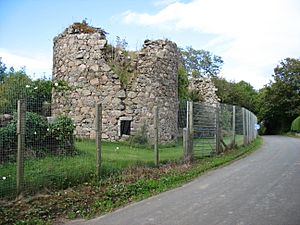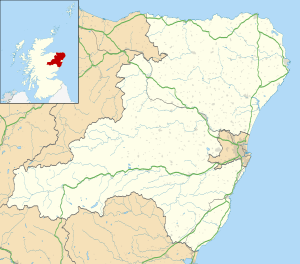Inverugie Castle facts for kids
Quick facts for kids Inverugie Castle |
|
|---|---|
| Inverugie, Aberdeenshire, Scotland | |

Inverugie Castle
|
|
| Coordinates | 57°31′31″N 1°49′50″W / 57.5252°N 1.8305°W |
| Type | motte-and-bailey |
| Site information | |
| Open to the public |
no |
| Condition | ruined |
| Site history | |
| Built | 12th and 17th centuries |
Inverugie Castle, also known as Cheyne's Tower, is a ruined castle in Aberdeenshire, Scotland. It was once a strong motte-and-bailey castle. Today, it is a special protected site called a scheduled ancient monument.
Contents
Where is Inverugie Castle?
Inverugie Castle is found near Peterhead on Scotland's northeast coast. The castle ruins are a small mound. This mound is about three metres high. It stands above the River Ugie.
This small mound is what's left of the first wooden castle. The Cheyne family built this original castle in the 12th century. The stone parts you see today were built much later.
What was the First Castle Like?
The first castle at Inverugie was a motte-and-bailey design. A "motte" is a raised earth mound. A "bailey" is a courtyard surrounded by a fence or wall.
This castle was built close to the River Ugie. This suggests it was meant to protect a ford (a shallow river crossing). The bailey likely had a ditch, or moat, around it. Water from the River Ugie would have filled this moat. This made the castle even harder to attack.
What was the Later Stone Castle Like?
The later stone castle was an oblong tower house. It had several levels. The lowest level, or basement, was used for storage. It also held the kitchen.
Above the basement was the main hall. This large room was used for entertaining guests. Small spiral stairs, called turnpike stairs, were in the north and south corners of the hall. These stairs led to two round towers.
A third tower was on the west side. This tower held the main staircase. It faced a cobbled courtyard. This courtyard's wall was right beside the River Ugie.
History of Inverugie Castle
A defensive building was first constructed at Inverugie in the 12th century. The Cheyne (Le Chen) family built this early structure.
How the Castle Changed Hands
In 1345, Reginald le Chen, who owned Inverugie, passed away. The Inverugie estate then went to the Keith family. They were known as the Earl Marischals. Their main home was Dunnottar Castle. The Keiths gained Inverugie through a marriage. Edward Keith married Marjory, Reginald le Chen's daughter.
Around 1660, the Keith family built the stone castle we see in ruins today. This new castle was built south of the original wooden mound.
A Shield and a Poet's Father
In the 1800s, an old oak shield was found in a local house. This shield had the family crest of William Keith, 7th Earl Marischal. It was carved with the date 1660.
The Keith family lost their lands after the Jacobite Rebellion of 1745. This happened because they supported the Jacobite cause. After 1745, the Inverugie estate was given to James Ferguson. He was the third Laird of Pitfour. He kept the castle in great condition until he died in 1820.
However, the next owner, the fifth Laird, removed all the repairs. The person who owned it after him neglected the castle even more.
The Castle's Final Days
By 1890, the castle was in very poor shape. It could not stand up to bad weather. Strong winds in April 1890 caused some walls to fall down. The stair tower also collapsed.
After more storms on New Year's Day 1899, the local council said the castle was unsafe. The estate manager, William Ainslie, likely followed orders from the owner. He arranged for much of the remaining ruins to be blown up. This made the rest of the structure even weaker. Within two weeks, almost nothing was left of the castle.
What Experts Said
Charles McKean, an expert on castles, described Inverugie as a "splendid double-courtyard Renaissance chateau." He also said it was a "four-storey block with circular angle towers and a stair turret."
Interestingly, William Burnes (1721 – 1784) worked at Inverugie Castle. He was the father of the famous Scottish poet, Robert Burns. William Burnes was born nearby and trained as a gardener at Inverugie. He later moved to Ayrshire.


